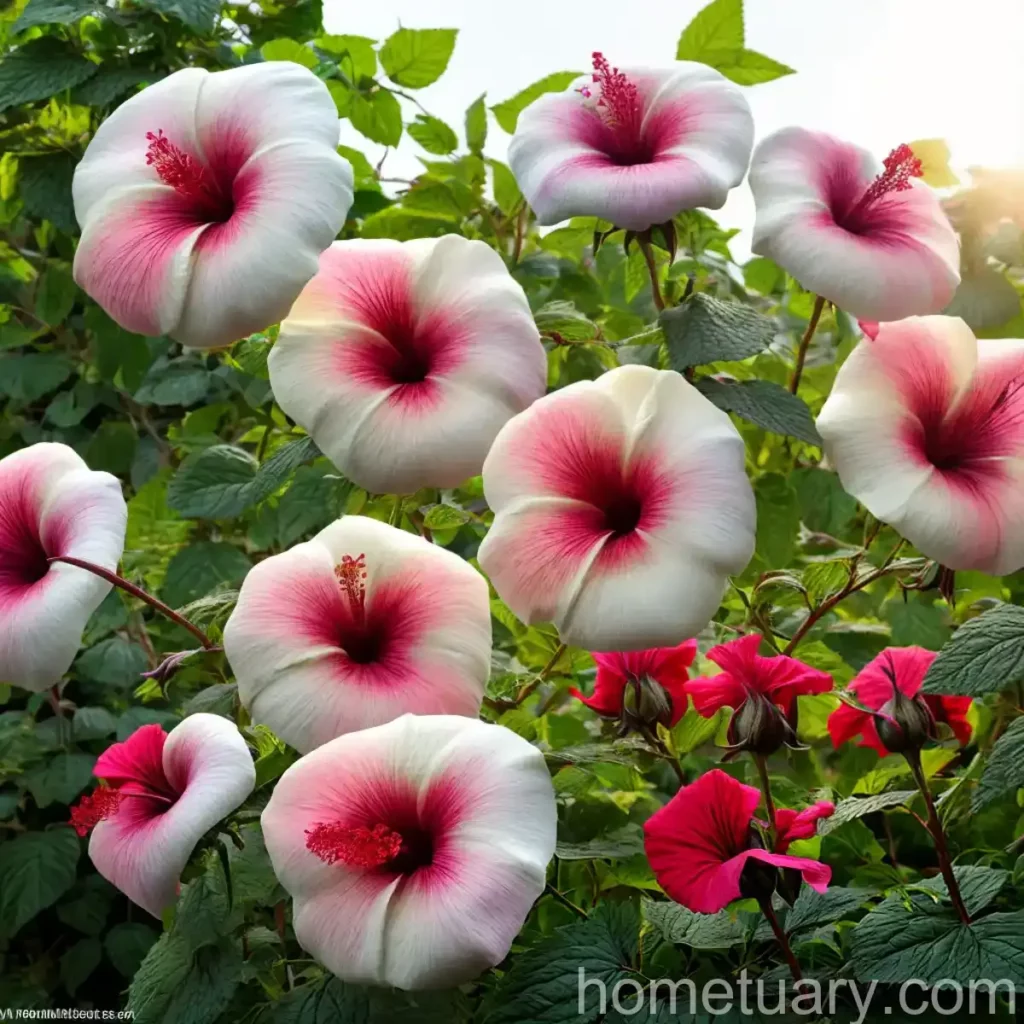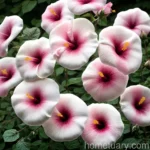Rose Mallow (Hibiscus moscheutos subsp. palustris): A Comprehensive Guide
Introduction
Rose mallow, scientifically known as Hibiscus moscheutos subsp. palustris, is a stunning perennial plant that belongs to the family Malvaceae. Also referred to as swamp rose mallow, this native hibiscus species is cherished for its large, showy flowers and attractive foliage. Its ability to thrive in moist, swampy conditions makes it an ideal choice for wetland restoration and wildlife gardens. In this comprehensive guide, we will explore the culture, uses, ideal growing conditions, and maintenance techniques for rose mallow, as well as tips for disease and pest control. Additionally, we will uncover the fascinating fun facts and unique features that make rose mallow a standout addition to any landscape.
Key Takeaways – Rose Mallow (Hibiscus moscheutos subsp. palustris)
Before delving into the details, let’s take a quick look at the key takeaways about rose mallow:
- Botanical Name: Hibiscus moscheutos subsp. palustris
- Other Names: Swamp rose mallow, palustris hibiscus
- Plant Type: Perennial flowering plant
- Ideal Growing Conditions: Moist, swampy areas
- Flower Colors: Pink, white, purple, and vibrant hues
- Growth Habit: Upright, vigorous growth with showy blooms
- Unique Features: Attractive foliage, large flowers, and ornamental characteristics
- Uses: Landscaping, wetland restoration, wildlife gardens, and traditional medicine
- Garden Benefits: Attracts pollinators, wildlife-friendly, and adds visual interest to garden borders.
Now, let’s dive into the details of cultivating and caring for this extraordinary plant.
Culture
Water
Rose mallow is a moisture-loving plant, and hence requires consistent moisture for optimal growth and blooming. When establishing a new plant, regular watering is vital to help it acclimate to its surroundings. Once established, it is important to ensure that the plant receives sufficient water, especially during dry spells. In regions with regular rainfall, supplemental watering may not be necessary, but in drier climates, regular irrigation is recommended.
Sunlight
For the best display of its vibrant flowers, rose mallow thrives in full sun. However, it can also tolerate partial shade, especially in hotter climates where some afternoon shade can be beneficial. In northern regions, providing the plant with a full day of sunlight is ideal for promoting vigorous growth and abundant flowering.
Fertilizer
To encourage healthy growth and prolific flowering, feeding rose mallow with a balanced, slow-release fertilizer in early spring is beneficial. A fertilizer with a higher phosphorus content can help promote blooming, while also providing essential nutrients for overall plant health. It is important to follow the application instructions provided on the fertilizer packaging and avoid over-fertilization, which can lead to excessive foliage growth at the expense of flowers.
Soil
Rose mallow thrives in moist, well-draining soil that is rich in organic matter. While it excels in swampy areas, it is crucial to avoid waterlogged conditions. When planting in gardens, amending the soil with compost can help improve its moisture retention and fertility. Additionally, a slightly acidic to neutral soil pH is ideal for promoting optimal nutrient uptake by the plant.
Pruning
Pruning rose mallow is essential to maintain its vigor, promote branching, and encourage prolific blooming. In late winter or early spring, prune the plant to remove any dead or weak growth, as well as any crowded or crossing branches. This practice helps improve air circulation within the plant, reducing the risk of fungal diseases. Additionally, spent flowers can be deadheaded throughout the growing season to promote continuous blooming and prevent the plant from directing energy into seed production.
Propagation
Rose mallow can be propagated through various methods, including division, softwood cuttings, and seeds.
-
Division: In early spring, mature plants can be divided to create new plants. Carefully dig up the clump and separate the individual plants, ensuring that each division has a good root system attached. Replant the divisions in suitable locations and ensure they receive adequate moisture during the establishment phase.
-
Softwood Cuttings: During the growing season, take softwood cuttings from the tips of healthy shoots. Remove the lower leaves and dip the cut end in a rooting hormone to encourage root development. Plant the cuttings in a well-draining growing medium and keep them consistently moist until roots have formed.
-
Seeds: Collect mature seeds from the plant after the flowering season. Sow the seeds in a well-prepared seedbed in the garden or in containers. Keep the soil consistently moist until germination occurs, and provide protection from extreme temperatures.
Container Popularity
The appeal of rose mallow extends to container gardening, where it can be showcased on patios, balconies, or in smaller gardens. Its striking flowers and attractive foliage make it a standout addition to any container garden, adding visual interest and a touch of elegance. When selecting a container for rose mallow, choose one that provides ample room for root growth and has drainage holes to prevent waterlogging. Regular watering and fertilization will be essential for container-grown plants to support their growth and flowering.
Common Diseases
While rose mallow is a relatively resilient plant, it can be susceptible to certain diseases, particularly in conditions that promote high humidity and poor air circulation. The most common diseases that may affect rose mallow include:
-
Powdery Mildew: This fungal disease appears as a white, powdery coating on the leaves and stems, leading to leaf distortion and reduced photosynthesis. To control powdery mildew, ensure good air circulation around the plant, avoid overhead watering, and remove and destroy affected plant parts.
-
Leaf Spot: Leaf spot diseases manifest as dark spots on the leaves and can lead to premature leaf drop and reduced plant vigor. To manage leaf spot, remove and destroy affected foliage, avoid overhead watering, and apply fungicidal treatments if necessary.
-
Root Rot: Excessive soil moisture can lead to root rot, causing the plant to wilt and exhibit general decline. To prevent root rot, ensure proper soil drainage and avoid overwatering the plant.
Disease Diagnosis
Diagnosing diseases in rose mallow involves careful observation of the plant’s symptoms, including the appearance of the foliage, stems, and overall plant vigor. Additionally, environmental conditions and recent care practices should be considered when identifying potential disease issues. If unsure about a diagnosis, consulting with a local extension office or plant health specialist can provide valuable insights and recommendations for disease management.
Common Pests
Rose mallow is relatively resistant to pest infestations, but can occasionally attract certain insects. Some of the common pests that may affect rose mallow include:
-
Aphids: These small, soft-bodied insects feed on the plant’s sap and can cause distorted growth and honeydew production. Regular monitoring and the application of natural predators can help control aphid populations.
-
Japanese Beetles: These voracious feeders can skeletonize the leaves of rose mallow, leading to unsightly damage. Handpicking beetles and using pheromone-based traps can be effective in managing their numbers.
-
Whiteflies: These tiny insects can congregate on the undersides of leaves, causing yellowing and weakening of the plant. Natural predators, such as ladybugs and lacewings, can be introduced to control whitefly populations.
Botanist’s Tips
To ensure the successful cultivation of rose mallow and maximize its ornamental value, consider the following tips:
- Mulching: Applying a layer of organic mulch around the base of the plant can help conserve soil moisture, suppress weeds, and improve overall soil health.
- Support: In regions with exposure to strong winds, providing staking or support for taller varieties of rose mallow can prevent stem damage and maintain an upright growth habit.
- Deadheading: Regularly removing spent flowers not only encourages continuous blooming but also prevents the plant from setting seed and potentially becoming invasive in certain regions.
Fun Facts
- The flowers of rose mallow are not only visually stunning but also attract a wide range of pollinators, including bees, butterflies, and hummingbirds, adding a lively element to any garden.
- In traditional medicine, various parts of the rose mallow plant are used for their soothing and medicinal properties, offering potential benefits for herbal teas and natural remedies.
Links to External Resources
For further information and in-depth resources on rose mallow, refer to the following:
-
The American Rose Mallow Society: A comprehensive resource for hibiscus enthusiasts, offering information on cultivation, species diversity, and conservation efforts.
-
University Extension Services: Local extension offices and university resources provide valuable insights into plant care, disease management, and best practices for growing rose mallow.
-
Botanical Gardens: Many botanical gardens feature extensive collections of hibiscus species, offering opportunities to observe various cultivars and species in diverse settings.
-
Plant Pathology Resources: Accessing plant pathology resources can provide detailed information on disease diagnosis, integrated pest management, and sustainable plant care practices.
Conclusion
In conclusion, rose mallow (Hibiscus moscheutos subsp. palustris) is an enchanting perennial plant with a wide array of uses, from its ornamental value in landscaping to its potential role in wetland restoration and traditional medicine. By embracing its cultural preferences, providing adequate care, and employing disease and pest management strategies, gardeners can celebrate the beauty and resilience of this exceptional plant. Whether adorning garden borders, enlivening container gardens, or contributing to conservation efforts, rose mallow stands as a testament to the allure and versatility of native hibiscus species.
With its vibrant flowers, moisture-loving nature, and ecological significance, rose mallow continues to captivate plant enthusiasts and conservationists alike, embodying the rich diversity and enduring charm of native flora.
Remember, the key to successfully growing and enjoying the beauty of rose mallow lies in understanding and respecting its natural habitat and requirements, and by doing so, this stunning plant will thrive and grace your garden with its iconic blooms and alluring presence.
The comprehensive guide provides information about the culture, uses, ideal growing conditions, and maintenance techniques for rose mallow, also known as Hibiscus moscheutos subsp. palustris. It includes tips for disease and pest control, fun facts, and links to external resources for further reading.
Keywords: Hibiscus moscheutos, Swamp rose mallow, Palustris hibiscus, Native hibiscus species, Perennial hibiscus plant, Hibiscus with medicinal properties, Ideal growing conditions for rose mallow, Rose mallow pest and disease control, Rose mallow for container gardening















